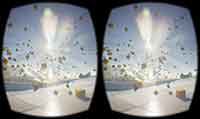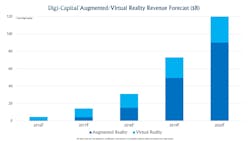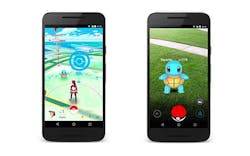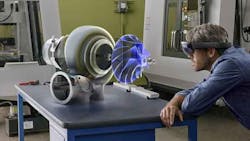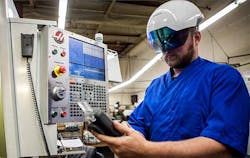Love it or hate it, by now you’ve probably heard of Pokémon GO. The augmented reality app has become a global phenomenon on an unprecedented scale, having been installed more than 100 million times since launching July 6 and generating about $10 million (through in-game purchases) a day via the Apple Store and Google Play, according to AppAnnie.
The explosion is obviously great for game developer Niantic, as well as license holders Nintendo and the Pokémon Company, but the app, which places imaginary animals into your environment to interact with via your smartphone, has also sent shock waves throughout the nascent industry trying to integrate wearables and digital-dependent realities into people’s everyday life. The popular mantra of Pokémon is that you “gotta’ catch ‘em all,” meaning the game’s digital pocket monsters, but it appears the game itself has captured our collective desire to meld more seamlessly with the digital world.
Photo: Lam Yik Fei/ Getty Images
“Seeing the adoption of a game like Pokémon GO and what [Niantic] has been able to do in the past couple of weeks, is really raising awareness of what augmented reality and mixed reality are,” says Jeff Jenkins, CTO of APX Labs, a software company that brings wearable software solutions to enterprises and industrial clients, “and I think that’s really a great thing.”
So how is millions of people obsessively chasing after digital dragons raising awareness of anything besides how our society is devolving into a South Park episode?
“We found initially, trying to bring this tech to workers with wearable devices, a lot of our job was in education,” Jenkins says.
APX Labs flagship software, called Skylight, is basically Windows for Wearables. It allows an engineer to record the replacement of a pump from the camera embedded in his smart glasses, or overlay critical contextually usable data on the lens. This is what’s known as assisted reality, and a futuristic version was highlighted in the 2002 movie Minority Report.
There’s also, mixed reality (projects 3D modeled objects into environment, Microsoft HoloLens), augmented reality (enhances environment like Pokémon GO), and virtual reality (totally immersive, like the Oculus Rift).
Keeping them all straight has been as daunting a task as me trying to identify the band members of One Direction.
“If you walked down the street before this application was released and asked people what they thought of augmented reality, the chances of hitting somebody outside of Silicon Valley that would be well informed would be pretty low,” Jenkins says.
Now, because of the game, people have a frame of reference for AR, making the job of APX Labs and similar companies that much easier.
“It’s usually pop culture or sci-fi that has inspired how stuff is getting used in the real world,” he says.
This means that along with awareness, the game could promote mainstream adoption of AR.
“The devices we’re used to – phones, desktops, and laptops -- are really just the tip of iceberg in how humanity is destined to interact with digital content,” Jenkins says. “We yearn to interact in a more natural way.”
This evolution was going to happen with or without Pokémon Go. Augmented and Virtual Reality was already projected to hit $120 billion by 2020, according to Digi-Capital. To put that in perspective, take a look at this graph:
Pokémon GO has accelerated it, although to what level is unclear. It very well could be the “Skynet” moment for augmented reality. That’s when a technology transcends its intended use and takes on an unexpected life of its own, like the artificial intelligence in the Terminator franchise.
But AR is to AI as teaching a man to fish is to having an omnipotent being trawl the whole ocean and give you one. It’s a tool used for human empowerment, not one that lets our tools enslave us.
Still, AR is a new, unknown technology. Like robots, GMOs, and vaccines, it elicits excitement from many, and incites fear in others.
Upon release, one major worry was that the game was BigBrother plot to steal your emails because of certain access requests, as if the Illuminati has time to run the music industry and read about who you’ll draft in your fantasy football league. This was summarily debunked by Niantic, although to be fair, if Big Brother existed, that’s exactly what they would want you to believe.
So far, the game is fairly innocuous, despite the headline-grabbing gamers who walk off cliffs or abandon their kid to expandtheir Pokédex (Pokémon checklist). If 100 million people do anything, at least a few will find a way to do it stupidly. This game merely augments Darwinism.
It’s really nothing to fear. Mostly.
How the Game Works
Unless you’ve been living under a geodude, you know the basic premise: the pocket monsters from the OG 1990s Nintendo Game Boy games are all around us, and this free app allows you to locate them using geospatial positioning, and to see them IRL via the camera on your smartphone.
augmented view of the environment your camera sees.
Photos: Niantic
Just flick a Poké Ball (by sliding your thumb on your screen) in the Pokémon’s direction to capture and imprison the wild cartoon beasts. After that, you can feed it candy and stardust (essentially PGH, or Pokémon Growth Hormones) and force it to fight for your glory at designated Gyms (usually popular area landmarks), and sell the weak ones for more drugs.
That may sound like some horrific digital blood sport even the North Koreans would find inhumane, but it’s pretty damn addictive and promotes an active lifestyle. You have to explore different regions, such as urban areas or coastal regions, to flush out different types (rock, grass, electric) of Pokémon, and you must also walk 2 to 10 km to hatch their eggs (driving won’t do as it doesn’t count if you’re moving more than 12 mph). Only by doing both, for an extended amount of time, can you catch all 142.
One guy from Brooklyn, Nick Johnson, caught all 145 (the three others are exclusive to Europe, Asia, and Oceania) in less than a month. He caught the 142 indigenous to America while still working 50 hours a week at a startup, and the last three through a sponsorship with Expedia and Marriott Rewards.
And contrary to the image you may have of someone who would achieve such a feat, the 28-year-old Johnson has a real life girlfriend, who often joined him on his quest.
If you walk by any park or municipal meeting place in your town, you may see others like Johnson, in crowds or alone, searching for that elusive, adorable Eevee, while mostly only catching another dumb ol’ Pidgey or Rattatta, the ubiquitous pigeons and rats of the Poké World.
train tracks to catch Pikachu, because there's a 29% chance of death.
Photo: Drew Angerer/ Getty Images
This may appear as if the whole world has gone crazy, or turned into zombies, but the stats suggest otherwise.
Users spend about 45 minutes a day playing, and while that sucks up a lot of service plan data, research has found it hasn’t drastically altered anyone’s day-to-day routine.
“As Pokémon GO’s gameplay relies on users being out and about, consumers seem to have incorporated the game into their daily routines and commutes,” writes AppAnnie analyst Sameer Singh.
At the very least, it’s augmenting the boring parts of people’s lives. You could choose to use your mobile device as a black hole to suck you into horrible click bait articles, or you could convert your display into a lens for which to perceive and interact with your surroundings in a new way.
Summer of Pikachu
The Pokémon GO phenomenon could be written off as a summer anomaly that found a way to leverage millennial nostalgia and a novel technology. However, this game now has more users than Tinder, a dating app which literally lets you find hot people near you to have sex with. If that doesn’t suggest staying power, I don’t know what does.
It’s nowhere near perfect representation of augmented reality, though.
“I don’t know if this is a ‘Facebook’ moment,” Jenkins says, referring to the app that terraformed social media into a powerful agent of global change. “What I do think is going to happen is not last game we’re going to see.”
He expects other brands to experiment, reinvent, copy and deconstruct what Pokémon GO has started. And the myriad applications will spawn improved devices to play them on. If people really want to connect more organically with the artificial, they’ll need something that doesn’t promote poor posture and “text neck.”
“What if I could play this without having to hold my phone up and look at it?” Jenkins asks.
Wearable companies would love to answer that question, and find that crucial balance between capability and the way the device looks.
The technology has a long way to go. This game illustrates those flaws and why Jenkins thinks AR isn’t quite yet ready for widespread use.
He overheard some fellow employees being embarrassed to pull out their phones at lunch in a populated restaurant district, because the game is the visual equivalent of hearing someone on their Blue Tooth, but assuming they are schizophrenic.
“That social pressure makes the consumer market so unforgiving of current generation wearable devices,” he says. “Enterprise will lead the way and the consumer market will trail in [wearables such as] smart glasses just because of that social pressure alone.”
Smartwatches look less like Swatch watches and something a self-respecting adult would wear with every new iteration, and one company,Ringly, has even made discrete jewelry that will beep or blink to alert the user to notifications.
selfie in a classy, subtle way.
Screengrab: Ringly.com
The Microsoft HoloLens may provide the best chance for consumers to understand what mixed reality can do, but Jenkins says that the form factor is fine for the living room, but not walking down the street.
That’s a shame, because there is proof-of-concept for what Pokémon GO would look like on the platform. Check it out below:
Reality Bytes
The industrial sector isn’t as fashion-conscious, Jenkins says, valuing comfort, safety, and obviously function above all else. Any significant reality blending will happen here first, he believes.
“If it provides value, enterprise will adopt it,” Jenkins says. He says for the most part, “the technology isn’t there yet” for AR, and the totally immersive virtual reality, the latter currently mired at the crossroads of The Matrix and Minecraft.
Mixed reality could have the biggest industrial impact, as it would project a 3D modeled object, from a bracket to a boiler, in the actual work space. Instead of 3D printing a prototype or part, you can place the digital model on a design, have multiple collaborators see it from different angles, and manipulate it to make sure it’s the right size or color.
a part in a real work environment?
Image: Microsoft
For mixed reality to work on a large scale though, Jenkins says, “you have to make sure everything on that manufacturing floor is 3D modeled, tagged geospatially, and that you have some system in place to align that content with the real world. Most organizations don’t have that kind of database.”
In 2001, Wikipedia had just a few pages; now it has more than 4.5 million. The more square-footage of a plant or facility that’s geotagged and documented, the more benefit mixed reality will have, Jenkins says.
There’s also the issue of inaccuracy, something Wikipedia must constantly monitor its community for inaccuracies (here are 50 of the funniest), Pokémon GO shows how difficult it is to get geopositioning right, as your avatar could be several dozen yards away from where you’re actually standing.
That’s a huge hurdle industry must solve for widespread adoption.
“In a game, tolerances are different,” Jenkins says. “It’s OK if you’re a few meters off trying to catch Pokémon, but it’s not OK if you’re a few meters off if you’re trying to figure out which aisle to be in for pick and pack operation.”
The New Hope
One wearables company, DAQRI, has seemed to have found a balance between style and substance with its Smart Helmet. Reminiscent of something Judge Dredd or Robocop may wear, it provides the futuristic features you’d expect from such a badass looking helmet: a rugged Heads Up Display (HUD), Thermal vision, IR depth mapping, audio and video recording and playback, all while still being an ANSI compliant hard helmet and face shield.
an arsenal of IoT sensors.
Photo: DAQRI
“The safety aspect of wearing a helmet is the reason they are doing it. They don’t wear safety glasses because they flatter the shape of their eyes. It’s because it keeps them safe.”
Business Insider journalist Biz Carson got to try one out at the Daqri Los Angeles office – which was once the set of “Mad Men” – and says the helmet gave her super powers:
Imagine looking at a field of pipes and being able to identify them and what's flowing through them. Instead of keeping employees in the control room to monitor data, a worker could be able to tell if a measurement is out of line just by having the camera on the helmet read it. If needed, their boss could also tap into the cameras on the helmet to see the same view and troubleshoot together.
As technology does edge closer to Skynetting the hell out of us, or at least taking our manufacturing jobs, the question is how will we compete?
This tool answers that by providing the same omniscience the Internet of Things gives an ERP to human workers, who are vastly more mobile and flexible than any robot, yet can’t hope to compete with processing power. This gives us back the control we’re losing by outsourcing all complex tasks to algorithms.
I would make a The Matrix Revolutions reference here about Neo gaining IoT super powers outside of the virtual world, but that movie was just awful and no one should remember it.
Because of the price that ranges in the thousands, the smart helmet isn’t something every worker will start wearing next year. Like with any technology, the price will inevitably fall and in ten years a mechatronics engineer could be conducting a fleet of robo-workers on the factory floor like it’s an orchestra at the Philharmonic.
Sure, it’s crude now for the jerk in front of you on the sidewalk to stop short because he needs that Squirtle right now, but keep in mind this isn’t just a dorkier continuation of texting and walking. It’s the link to a world where instead of capturing imaginary monsters to fight our fake battles, we’ll be controlling drones and robots from our eyeglasses or even contact lenses to do the work we can’t.
With an aging workforce and skills gap, these enhancements could keep a company’s most knowledgeable employees on the floor longer, but at no detriment to their health. So even if you hate that clusters of kids doing something you don't understand, as all people over age 30 do, at least take solace in the fact that mobile gaming isn't the only thing that took a huge step in evolution this summer.
“You get a glimpse at where we could GO with Pokémon Go,” Jenkins concludes. “It’s a little peak at where the technology is headed.”














